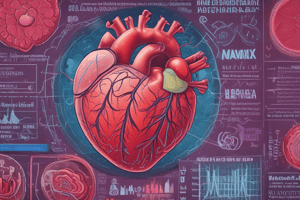Podcast
Questions and Answers
What is the purpose of echocardiography?
What is the purpose of echocardiography?
- To create moving images of the heart using sound waves (correct)
- To visualize the extent of perfusion of the arteries
- To determine the site of narrowing/blockage of the coronary arteries
- To map the forwards and backwards direction of blood flow
A 65- year old gentleman presents to A&E with central crushing chest pain. Which is the most appropriate diagnosis?
A 65- year old gentleman presents to A&E with central crushing chest pain. Which is the most appropriate diagnosis?
- Echocardiography
- Cardiac MRI
- Angiography (correct)
- Chest X-ray
A 79-year-old man with 3 previous MI's develops breathlessness and puffy ankles. Select the correct pathophysiology.
A 79-year-old man with 3 previous MI's develops breathlessness and puffy ankles. Select the correct pathophysiology.
- Greater circulating volume causing capillary hydrostatic pressure (correct)
- Increased fluid production due to circulating inflammatory cytokines
- Reduced circulating volume causing increased cardiac output
- □ Increased renal reabsorption of sodium causing increased blood pressure
An 83- year-old lady presents with pinky frothy sputum and breathlessness when lying flat. Spot the diagnosis.
An 83- year-old lady presents with pinky frothy sputum and breathlessness when lying flat. Spot the diagnosis.
You hear a murmur - S3 sound. Which is the imaging is the most appropriate test
You hear a murmur - S3 sound. Which is the imaging is the most appropriate test
Investigations found the cause is femoral artery stenosis. Which imaging was used to discover this.
Investigations found the cause is femoral artery stenosis. Which imaging was used to discover this.
A 49-year-old Caribbean lady develops headache and double vision. She thinks she has a brain tumour. Spot the diagnosis
A 49-year-old Caribbean lady develops headache and double vision. She thinks she has a brain tumour. Spot the diagnosis
A 59-year-old smoker has tightening pain in his leg on dog walks which resolve when he stops and rest. Spot the diagnosis.
A 59-year-old smoker has tightening pain in his leg on dog walks which resolve when he stops and rest. Spot the diagnosis.
What is the purpose of angiography?
What is the purpose of angiography?
What are some outward signs of cardiovascular disease?
What are some outward signs of cardiovascular disease?
What is the purpose of Doppler echocardiography?
What is the purpose of Doppler echocardiography?
What is hypercholesterolemia?
What is hypercholesterolemia?
What is central cyanosis?
What is central cyanosis?
What is the purpose of coronary angiography?
What is the purpose of coronary angiography?
What is Raynaud's phenomenon?
What is Raynaud's phenomenon?
What are some outward signs of hypercholesterolemia?
What are some outward signs of hypercholesterolemia?
What is the purpose of angiography?
What is the purpose of angiography?
What is the indication for coronary angiography?
What is the indication for coronary angiography?
What is the purpose of Doppler echocardiography?
What is the purpose of Doppler echocardiography?
What are some symptoms of heart failure?
What are some symptoms of heart failure?
What is the purpose of limb angiography?
What is the purpose of limb angiography?
What is the purpose of echocardiography?
What is the purpose of echocardiography?
What is the cause of Raynaud's phenomenon?
What is the cause of Raynaud's phenomenon?
What are the outward signs of hypercholesterolemia?
What are the outward signs of hypercholesterolemia?
What is the main symptom of heart failure?
What is the main symptom of heart failure?
What is the difference between echocardiography and doppler echocardiography?
What is the difference between echocardiography and doppler echocardiography?
What can central cyanosis be a sign of?
What can central cyanosis be a sign of?
Flashcards
Xanthomas
Xanthomas
Skin lesions caused by high cholesterol.
Corneal Arcus
Corneal Arcus
A white ring around the eye, caused by high cholesterol.
Cutaneous Xanthelomatosis
Cutaneous Xanthelomatosis
Multiple yellow bumps on the skin due to high cholesterol.
Raynaud's phenomenon
Raynaud's phenomenon
Signup and view all the flashcards
Peripheral Edema
Peripheral Edema
Signup and view all the flashcards
Heart Failure
Heart Failure
Signup and view all the flashcards
Central Cyanosis
Central Cyanosis
Signup and view all the flashcards
Hypercholesterolemia
Hypercholesterolemia
Signup and view all the flashcards
X-ray Imaging
X-ray Imaging
Signup and view all the flashcards
Echocardiography
Echocardiography
Signup and view all the flashcards
Doppler Echocardiography
Doppler Echocardiography
Signup and view all the flashcards
Angiography
Angiography
Signup and view all the flashcards
Coronary Angiography
Coronary Angiography
Signup and view all the flashcards
Limb Angiography
Limb Angiography
Signup and view all the flashcards
Cardiac Ischemia
Cardiac Ischemia
Signup and view all the flashcards
Cardiac Infarction
Cardiac Infarction
Signup and view all the flashcards
Valvular Heart Disease
Valvular Heart Disease
Signup and view all the flashcards
Left Ventricular Function
Left Ventricular Function
Signup and view all the flashcards
Left Ventricular Hypertrophy
Left Ventricular Hypertrophy
Signup and view all the flashcards
Atrial Fibrillation
Atrial Fibrillation
Signup and view all the flashcards
Embolus
Embolus
Signup and view all the flashcards
Pericardial Disease
Pericardial Disease
Signup and view all the flashcards
Pulmonary Embolism
Pulmonary Embolism
Signup and view all the flashcards
Congenital Heart Defects
Congenital Heart Defects
Signup and view all the flashcards
Aortic Arch
Aortic Arch
Signup and view all the flashcards
Clear Lung Fields
Clear Lung Fields
Signup and view all the flashcards
Study Notes
Outward Signs and Symptoms of Cardiovascular Disease & Diagnostic Imaging in the Cardiovascular System
- General observation of patients with cardiovascular disease can reveal signs of the disease in the hands, face, neck, trunk, and lower limbs.
- Hypercholesterolemia can cause xanthomas, corneal arcus, and cutaneous xanthelomatosis.
- Raynaud's phenomenon is a spasm of arteries that can cause reduced blood flow in the hands, which can lead to gangrene in severe cases.
- Heart failure can cause peripheral edema, shortness of breath, fatigue, and coughing.
- Central cyanosis can be seen in patients with chronic respiratory and/or cardiovascular disease.
- X-ray imaging uses high frequency electromagnetic waves to produce images of the body, which can reveal the position and size/shape of the aortic arch, clear lung fields, cardiac size, and costophrenic angle.
- Echocardiography uses sound waves to create moving images of the heart and is indicated for suspected valvular heart disease, abnormal left ventricular function, left ventricular hypertrophy, atrial fibrillation, embolus with a suspected cardiac source, pericardial disease, pulmonary embolism, and congenital heart defects.
- Doppler echocardiography can map the forwards and backwards direction of blood flow.
- Angiography involves injecting radio-opaque dye into arteries and taking x-rays in real time to visualize the extent of perfusion of the arteries and their branches.
- Coronary angiography is indicated in patients with symptoms of cardiac ischaemia/infarction and can help determine the site of narrowing/blockage of the coronary arteries.
- Limb angiography uses the same technique as coronary angiography to visualize the arteries in a leg.
- Kahoot quiz is available to test understanding of the material.
Outward Signs and Symptoms of Cardiovascular Disease & Diagnostic Imaging in the Cardiovascular System
- General observation of patients with cardiovascular disease can reveal signs of the disease in the hands, face, neck, trunk, and lower limbs.
- Hypercholesterolemia can cause xanthomas, corneal arcus, and cutaneous xanthelomatosis.
- Raynaud's phenomenon is a spasm of arteries that can cause reduced blood flow in the hands, which can lead to gangrene in severe cases.
- Heart failure can cause peripheral edema, shortness of breath, fatigue, and coughing.
- Central cyanosis can be seen in patients with chronic respiratory and/or cardiovascular disease.
- X-ray imaging uses high frequency electromagnetic waves to produce images of the body, which can reveal the position and size/shape of the aortic arch, clear lung fields, cardiac size, and costophrenic angle.
- Echocardiography uses sound waves to create moving images of the heart and is indicated for suspected valvular heart disease, abnormal left ventricular function, left ventricular hypertrophy, atrial fibrillation, embolus with a suspected cardiac source, pericardial disease, pulmonary embolism, and congenital heart defects.
- Doppler echocardiography can map the forwards and backwards direction of blood flow.
- Angiography involves injecting radio-opaque dye into arteries and taking x-rays in real time to visualize the extent of perfusion of the arteries and their branches.
- Coronary angiography is indicated in patients with symptoms of cardiac ischaemia/infarction and can help determine the site of narrowing/blockage of the coronary arteries.
- Limb angiography uses the same technique as coronary angiography to visualize the arteries in a leg.
- Kahoot quiz is available to test understanding of the material.
Studying That Suits You
Use AI to generate personalized quizzes and flashcards to suit your learning preferences.





